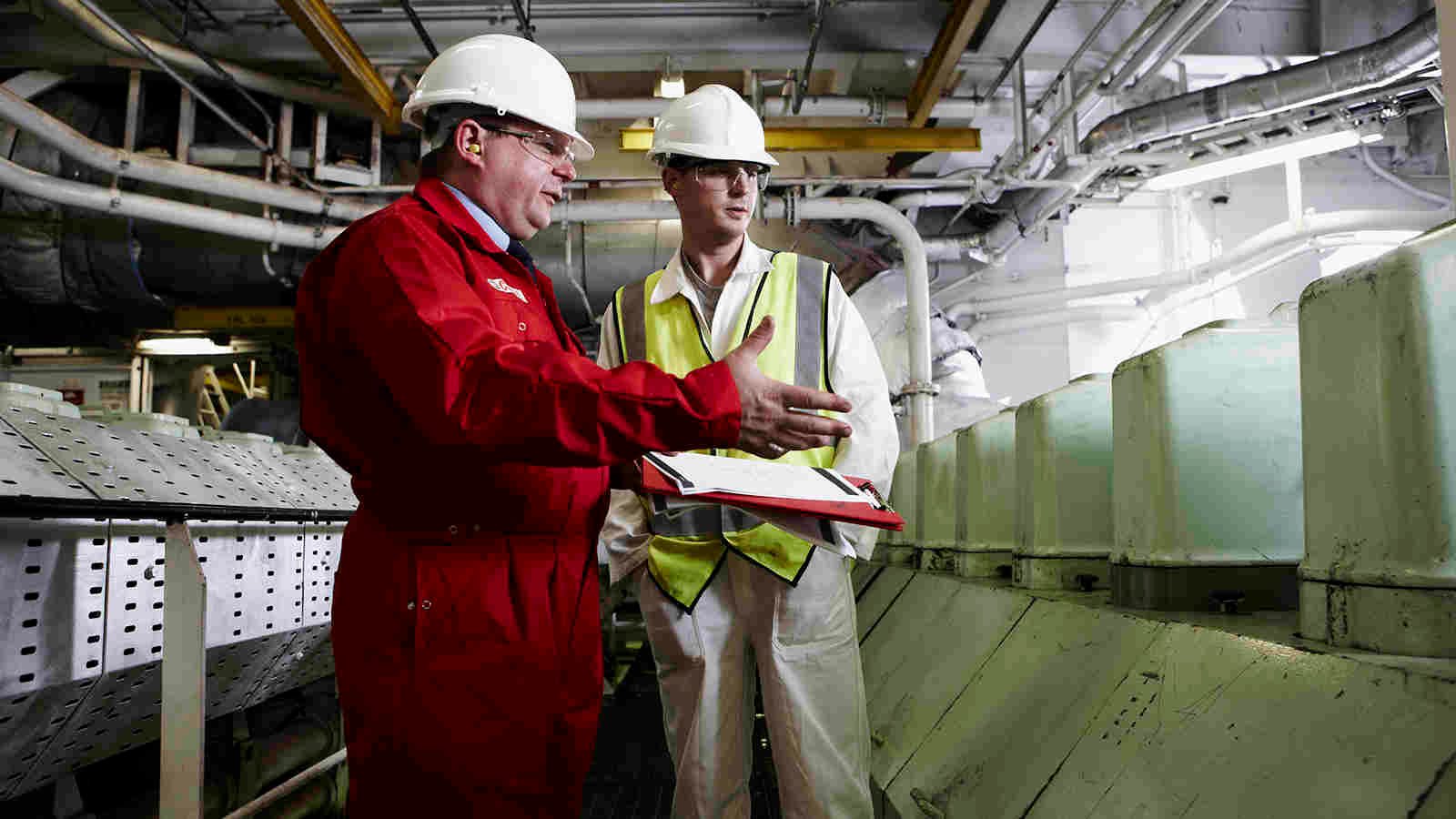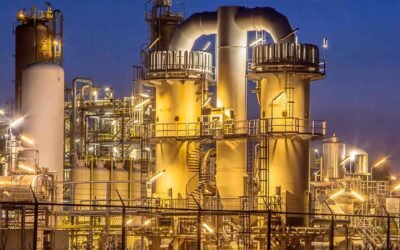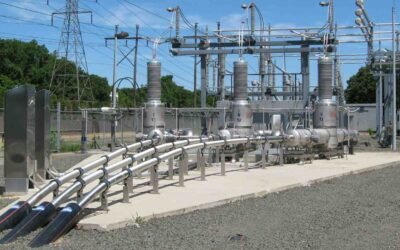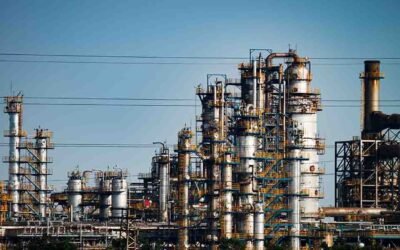About the Program
The objective of this PG Certificate course is to provide the candidates the Detail knowledge and skills in Health, Safety, & Environment (HSE) Engineering discipline to facilitate faster learning curves while on the job.
Health, Safety & Environment is a legal requirement for every organization (Industries, Mining Operations, Petroleum explorations, Infrastructure, etc.). It includes every environment where work is done. The importance of this field has become more relevant with the advancement in technology. For the enhancement of specific skills and knowledge related to health and safety among the engineers and science graduates willing to make a career in industries, construction, mining, etc.; the diploma will be a boon. It provides a career progression to the personnel working in the field of health, safety, and environment.
Learning objective
- Know state-of-the-art Oil & Gas production techniques and equipment technology,
- Understand all details of HSE issues linked to production, as well as to construction and maintenance works,
- Describe HSE management rules and individual responsibilities,
- Contribute to building an HSE culture in their organization,
- Participate efficiently to the crisis management team,
- Use efficient work methods and communication skills,
- Carry out projects and actions ensuring the highest standards in safety and respect for the environment.
Program Highlights

About The Course

Course Modules
- HSE MANAGEMENT:-Overview of HSE Management System
- Historical approach
- Initial development and current standards
- Introduction to the integrated management system
- Certification
- Industry approach
- Operating management system
- Fundamentals of HSE Management System
- Leadership
- HSE leadership characteristics
- Roles of safety leaders
- Communication and motivation
- Introduction to risk management
- Risk assessment process
- Continuous improvement
- PDCA cycle
- Management Commitment & Leadership
- Commitment and accountability
- Establishment of an HSE culture throughout the organization
- Importance of communication
- Management commitment
- HSE policy
- Strategies for the establishment of HSE objectives
- Main key performance indicators in the industry
- Establishment of compliance with legal requirements and industry standards
- Personnel management
- HSE competence assurance
- Training matrix
- Risk Management
- Establishment of risk assessment and control – Concepts, strategies and objectives
- Risk management tools, hazard identification, and risk register
- Risk map of activities
- Establishment of a corporate risk matrix
- Environmental and social impact assessment process
- Human factors and human error
- Management of change procedure
- Downgraded situations and simultaneous operations
- Safety design and asset integrity assurance – Main concepts
- Identification and management of safety-critical elements
- HSE Planning & Crisis Management
- Fundamentals of HSE management in projects
- Structure and elements of HSE plans
- Environmental management plans
- Structure for Emergency Response Planning
- Establishment of tiers and development from risk assessment information
- Crisis management organization and management of information and resources during emergencies
- Elements for Execution & Control
- Tools for risk assessment of execution activities
- Permit to work system
- Job safety analysis
- Observation and HSE awareness programs
- Pre-startup review
- Health and ergonomics management
- Logistics HSE management
- Audits & Continuous Improvement
- Elements for monitoring and reporting
- Undesired events reporting and investigation procedure
- Environmental and social monitoring
- Public reporting, sustainability reporting
- Audit planning
- Management of improving actions
- HSE IN PRODUCTION & MAINTENANCE ACTIVITIES:-Operations & HSE
- Hazards and risks incurred – Consequences
- Risk management means: equipment, organizational and human aspects
- Main Hazards of Hydrocarbon Processing
- Flammability: flame ignition and propagation principles; types of combustibles, oxidizers and most common ignition sources in process facilities
- Toxicity: exposure limits; specific hazards associated to H2S; use of Safety Data Sheet (SDS)
- Risk Assessment Tools – Job Safety Analysis
- Fundamentals of the risk assessment process
- Job Safety Analysis (JSA) procedure and steps
- JSA exercise
- Permit to Work System Procedure
- Permit To Work (PTW) system
- Objectives
- Roles and responsibilities
- Main elements of the PTW system
- Typical approval process and information flowchart
- Master permit and associated certificates
- Management of shift and rotation handover
- Permit renewals
- New technologies applied to the PTW system
- Hazard Identification & Risk Assessment of Maintenance & Construction Works
- Risk assessment and recommended mitigation measures associated to
- Lifting: manual and mechanical
- Work at height/over water/diving
- Use of tools: sandblasting, lifting, chemical and HP cleaning, hydraulic tests, flexible pipes, welding tools, milling
- Radioactive sources: hazards, markers, use
- Electrical equipment: electrical classes, hazards, habilitation, consignation, personal protection
- Confined space works: ventilation, gas detection, an oxygen content of air, penetration, evolution of hazard during works, supervision
- Hydrostatic testing
- Welding/grinding/cutting
- HSE IN SURFACE PRODUCTION OPERATIONS:-Operations & Hse
- Hazards and risks incurred
- Consequences
- Risk management means: equipment, organizational and human aspects
- Environmental Management in Maintenance & Construction Operations
- Main concepts
- Tools for environmental management
- Potential environmental impacts in maintenance and construction operations
- Waste management principles and strategies for planning and implementation
- Organizational Framework – Human Factors
- Introduction to HSE Management system
- Simultaneous Operations (SIMOPS) management
- Management of change
- Downgraded situations
- Learning from incidents and accidents: near misses, reporting and cause tree analysis
- Human factors in risk management, safe and unsafe habits, motivation, exemplarity, difficulties in improving safety results
- HSE Management Of Contractors
- Contractor management as a key element of HSE Management system
- Definition of elements for HSE contractor management from the selection process to final performance evaluation
- HSE risk assessment of contract scope
- Audits – Means Of Improving the HSE Performance
- Objectives of an audit
- Pre-audit preparations: audit boundaries, expectations, audit checklists, audit plans
- Audit: findings versus expectations
Course Certificates
SmartBrains is associated with The National Skill Development Corporation (NSDC) as the Training and Certification partner for various job oriented training programs across various sectors including Oil & Gas, Power, Renewable Energy, Hydrocarbon, IT & ITs, Electronics, Telecom, Agriculture, Life science etc. offering assessment based Training & certifications for a gamut of job profile.
Who should join?
- Working professionals in Domains: Site Engineering, Construction & Commissioning operation & Maintenance, Technicians in Process Engineering Field.
- Students (Mechanical, Civil, Chemical & Instrumentation Engineering, Diploma in Chemical .Engineering) who want to develop their career in Design Engineering.
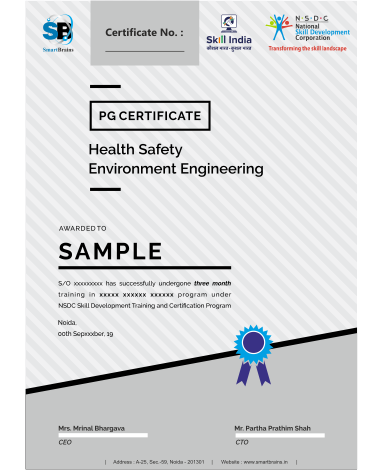
For Corporate queries
A-25, Sector-59, Noida (UP),India
Pin Code-201301
Connect with Program Advisor
training@smartbrains.com
+91 8955560560 | +91 9891108700
www.smartbrains.com
Nodal Centers
Noida, Dehradun
Guwahati, Pune
Course Features
- Lecture 0
- Quiz 0
- Duration 6 Months
- Skill level All levels
- Language English
- Students 0
- Assessments Yes

